Cackling Geese and Lesser Canada Geese, both subspecies of the Canada Goose, exhibit a fascinating array of characteristics that reflect their unique adaptations to diverse habitats.
While they share common ancestry, their subtle differences in size, behavior, vocalizations, and ecological preferences have given rise to distinct identities.
From physical traits like bill size and neck length to behavioral nuances such as migration patterns and social structures, these geese offer insights into the complexity of avian diversity.
Exploring these differences provides not only a means of identification but also a deeper understanding of the intricate interplay between genetics, environment, and behavior within the avian world.

Key Differences Between Cackling Goose and Lesser Canada Goose
There are some key differences between the two species:
Size
- Cackling Goose: Cackling Geese are consistently smaller, exhibiting a more compact body and shorter neck.
Their bill is smaller, and their head appears more proportionate to their body size. This subspecies tends to maintain a steeper forehead, giving their head a compressed appearance. - Lesser Canada Goose: Although typically smaller than other Canada Goose subspecies, the size distinction isn’t always straightforward. Some Lesser Canada Geese can approach the dimensions of Cackling Geese, blurring the differentiation.
They tend to have a slightly longer neck and larger bill than Cackling Geese, while displaying a rounder head with a sloping forehead.
Bill and Neck Length
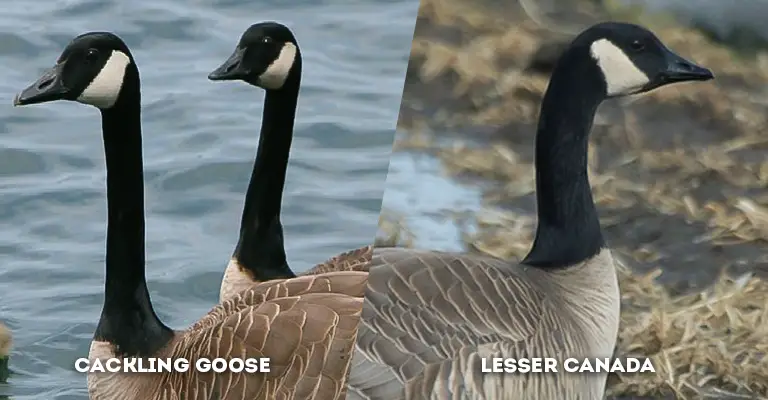
- Cackling Goose: Cackling Geese exhibit distinctive differences in bill and neck length compared to their counterparts. Their bills are notably smaller and more compact, reflecting their generally smaller size.
This shorter bill adds to their compressed appearance and can serve as a reliable indicator for identification. Additionally, their necks are relatively shorter, aligning with their compact body proportions. - Lesser Canada Goose: Lesser Canada Geese showcase subtle variations in bill and neck length. While they are typically smaller than other Canada Goose subspecies, some individuals can closely approximate the size of Cackling Geese.
However, an essential distinction lies in their neck length, which tends to be slightly longer compared to Cackling Geese. Their bills are larger in comparison as well, reflecting their overall size.
Head Shape
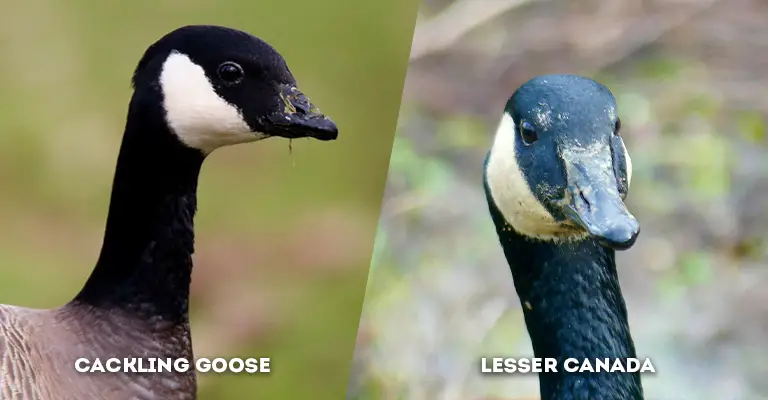
- Cackling Goose: The shape of the head is another key factor in distinguishing between these two subspecies. Cackling Geese possess a head with a distinctively steep forehead.
This creates a compact and rounded appearance, accentuating their smaller overall size. The shorter neck contributes to this head shape, resulting in a more compressed and streamlined profile. - Lesser Canada Goose: Lesser Canada Geese are characterized by a head with a rounder shape and a sloping forehead. This rounded head shape, combined with their longer neck, offers a more elongated and less compact look in comparison to Cackling Geese.
While the differences might seem subtle, careful observation of the head’s proportions and contour can aid in accurate identification.
Body Shape
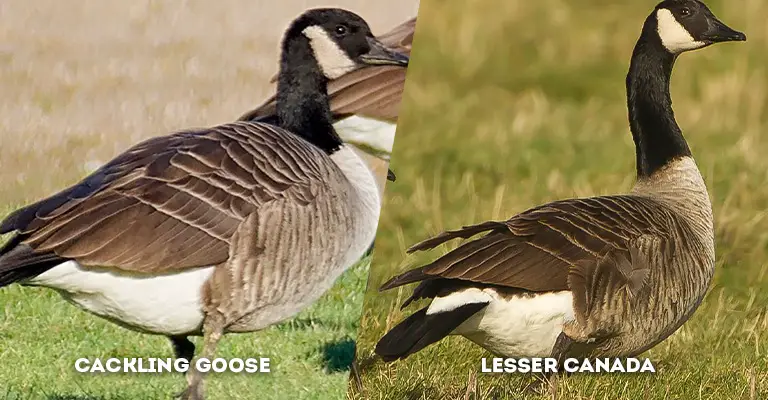
- Cackling Goose: The body shape of Cackling Geese is consistently smaller and more compact. This smaller size is reflected in their shorter bill, neck, and overall proportions.
Their bodies appear rounded, with a sleek and agile appearance that suits their active behavior. Despite their smaller size, their bodies still maintain a degree of robustness. - Lesser Canada Goose: While Lesser Canada Geese are generally smaller than other Canada Goose subspecies, their body shape might be slightly larger than that of Cackling Geese.
The size distinction, however, can sometimes be challenging to determine, as some Lesser Canada Geese can approach Cackling Goose dimensions.
Nonetheless, their overall body shape remains less compact than that of Cackling Geese, aligning with their longer neck and rounder hea
Vocalizations
- Cackling Goose: The vocalizations of Cackling Geese exhibit notable differences from those of Lesser Canada Geese. Cackling Geese have higher-pitched calls that often sound distinct and sharp.
Their calls might include a series of rhythmic notes that are relatively higher in frequency. These calls can serve as auditory markers for identifying Cackling Geese in the wild. - Lesser Canada Goose: Lesser Canada Geese, on the other hand, have their own distinct vocalizations, which might require a trained ear to differentiate from other Canada Goose subspecies.
Their calls can vary but often have a different pitch compared to the higher-pitched calls of Cackling Geese. Familiarity with the vocalizations of both subspecies is crucial for accurate identification, especially in situations where visual cues might be limited.
Plumage Variation
- Cackling Goose: Cackling Geese exhibit a range of plumage variations, with patterns that can differ among individuals. These variations can include differences in coloration, markings, and patterns on their feathers.
However, the plumage of Cackling Geese tends to showcase more distinct contrasts in colors, making them stand out even within a flock. - Lesser Canada Goose: Lesser Canada Geese also display plumage variations, but these variations are often less pronounced compared to Cackling Geese. Their plumage tends to be more consistent and uniform in color and patterns.
This can make identifying individual birds within a flock more challenging, as they might appear relatively similar in terms of their feather patterns and coloration.
Range
- Cackling Goose: Cackling Geese have a relatively wider distribution compared to Lesser Canada Geese. They can be found in various parts of North America, including both the eastern and western regions. This broader range contributes to their adaptability to different environments and habitats.
- Lesser Canada Goose: Lesser Canada Geese are more associated with northern regions, often being found in Arctic tundra habitats.
They tend to have a more restricted range compared to Cackling Geese. Their preference for colder environments reflects their adaptation to the specific conditions of northern territories.
Habitat
- Cackling Goose: Cackling Geese are versatile in their habitat preferences, often being observed in a range of environments.
They are known to inhabit urban areas, agricultural fields, and wetlands. Their adaptability to different habitats is reflected in their ability to thrive in both natural and human-altered landscapes. - Lesser Canada Goose: Lesser Canada Geese are strongly associated with wetlands and water bodies, particularly during their breeding seasons.
They prefer habitats such as marshes, ponds, and lakes, where they can find suitable foraging opportunities. While they might also inhabit agricultural fields, their affinity for wetlands is a defining characteristic.
Migration Patterns
- Cackling Goose: Cackling Geese exhibit diverse migration patterns, often migrating along different flyways.
Some populations of Cackling Geese are known for undertaking long migratory journeys, traveling thousands of miles between their breeding and wintering grounds.
These migration patterns contribute to the dynamic nature of their populations across various regions. - Lesser Canada Goose: Lesser Canada Geese also exhibit varying migration patterns, but their migrations might be more specific to their northern breeding grounds.
They might not undertake as extensive migratory journeys as some populations of Cackling Geese. Instead, they are more likely to migrate within the northern regions where they breed and overwinter.
Bill Color
- Cackling Goose: Cackling Geese typically have darker-colored bills, which can range from black to dark gray. This bill coloration contrasts with their plumage and can vary slightly among individuals. The dark bill color adds to their distinct appearance and aids in their identification.
- Lesser Canada Goose: Lesser Canada Geese often have bills that are more orange-yellow in color, creating a noticeable contrast with their overall appearance. This bill coloration sets them apart from Cackling Geese and contributes to their distinctive look.
Neck Length
- Cackling Goose: Cackling Geese have relatively shorter necks, which align with their overall smaller size and compact body proportions. The shorter neck contributes to their streamlined appearance and can be a distinguishing feature when observing them in the field.
- Lesser Canada Goose: Lesser Canada Geese possess slightly longer necks compared to Cackling Geese.
While this distinction might not be immediately apparent, especially from a distance, careful observation can reveal the difference in neck length, especially when considering other identifying characteristics.
Leg Color
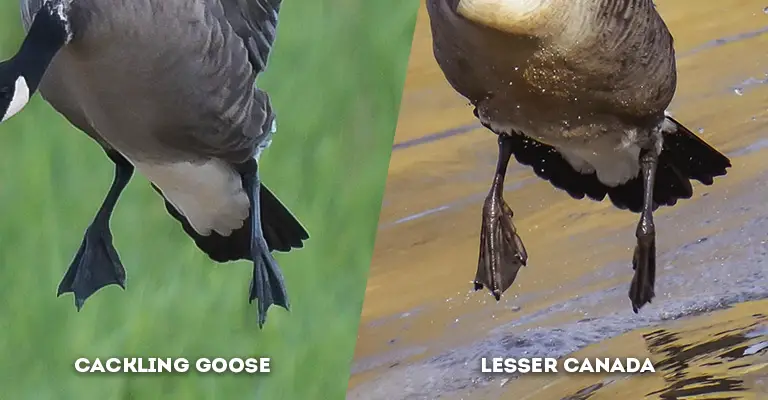
- Cackling Goose: The leg color of Cackling Geese varies, often leaning towards darker hues. Their legs can range from dark gray to black, and this coloration contrasts with their body feathers. The darker leg color can be a helpful indicator in differentiating them from other goose species.
- Lesser Canada Goose: Lesser Canada Geese typically have lighter-colored legs, often in shades of pink or light gray.
This leg color contrasts with their body feathers as well, creating a distinctive visual cue. Observing leg color, along with other traits, can aid in the accurate identification of these geese.
Eye Size
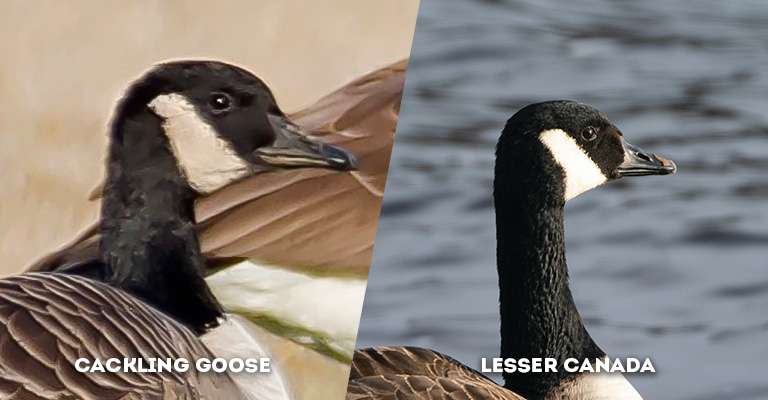
- Cackling Goose: Cackling Geese tend to have relatively larger eyes compared to other goose species. The size of their eyes contributes to their overall facial proportions and can be noticeable when observing them up close.
- Lesser Canada Goose: Lesser Canada Geese have smaller eyes compared to Cackling Geese. While this distinction might not be easily discernible from a distance, paying attention to eye size, along with other characteristics, can assist in identifying the specific goose subspecies.
Neck Thickness
- Cackling Goose: Cackling Geese often exhibit thicker necks, which align with their more robust body proportions. This thicker neck, combined with their smaller size, contributes to their distinctive appearance and overall body structure.
- Lesser Canada Goose: Lesser Canada Geese tend to have slimmer necks in comparison to Cackling Geese.
This difference in neck thickness can be more pronounced when observing them side by side, and it reflects their overall body proportions and adaptation to their specific habitats.
Feeding Behavior
- Cackling Goose: Cackling Geese exhibit a varied feeding behavior that includes grazing on grasses and crops in fields. Their ability to thrive in different habitats allows them to take advantage of agricultural landscapes and open areas.
- Lesser Canada Goose: Lesser Canada Geese are known for their preference for aquatic plants and grasses, particularly in wetland habitats.
They are often observed foraging in marshes, ponds, and lakes, where they can access their preferred food sources. This feeding behavior is closely tied to their ecological role in their chosen habitats.
Voice Pitch
- Cackling Goose: Cackling Geese are known for their distinct vocalizations characterized by a higher pitch.
Their calls often have a sharp and rhythmic quality, setting them apart from other goose species. This higher-pitched vocalization is a reliable auditory cue for identifying Cackling Geese. - Lesser Canada Goose: Lesser Canada Geese have vocalizations that differ in pitch from those of Cackling Geese. While their calls might vary in pitch, they generally have a different tonal quality compared to the sharper and higher-pitched calls of Cackling Geese.
Breeding Locations
- Cackling Goose: Cackling Geese breed in various habitats across North America, including both eastern and western regions. They can be found nesting in a range of environments, adapting to different conditions for successful reproduction.
- Lesser Canada Goose: Lesser Canada Geese are often associated with northern breeding locations, including Arctic tundra regions.
They have a strong affinity for nesting in wetlands, particularly in areas with marshes, ponds, and lakes that provide suitable conditions for breeding.
Feeding Habitat
- Cackling Goose: Cackling Geese are versatile in their feeding habits and can be observed grazing on grasses and crops in fields. They are adaptable to different environments, including agricultural landscapes and urban areas.
- Lesser Canada Goose: Lesser Canada Geese have a preference for feeding in wetland habitats, where they can access aquatic plants and grasses. Marshes, ponds, and lakes provide them with the necessary food sources for their survival and reproduction.
Bill Size
- Cackling Goose: Cackling Geese have relatively smaller bills that are proportionate to their overall body size. Their bills are compact and contribute to their streamlined appearance, reflecting their smaller stature.
- Lesser Canada Goose: Lesser Canada Geese have larger bills compared to Cackling Geese. This size difference is more noticeable when comparing the two subspecies directly. The larger bill is in accordance with their slightly larger body size.
Migration Distance
- Cackling Goose: Cackling Geese are known for their diverse migration patterns, often traveling along different flyways across North America.
Some populations undertake extensive migratory journeys, traveling thousands of miles between their breeding and wintering grounds. - Lesser Canada Goose: Lesser Canada Geese might not migrate as extensively as some Cackling Goose populations. Their migrations are often more region-specific, aligning with their northern breeding and overwintering habitats.
Behavioral Traits
- Cackling Goose: Cackling Geese are characterized by their agile and active behavior. They are often seen engaging in energetic activities, such as foraging and moving around in search of food.
Their smaller size and streamlined bodies contribute to their agility, allowing them to navigate various environments with ease. - Lesser Canada Goose: Lesser Canada Geese can exhibit a more sedate demeanor compared to Cackling Geese.
Their behavior is often less frenetic, and they might spend more time engaged in feeding and less time in constant motion. This behavioral difference can be influenced by their preference for specific habitats and food sources.
Social Structure
- Cackling Goose: Cackling Geese tend to form larger flocks, often congregating in groups that can include a mix of individuals from different age groups.
These flocks provide safety in numbers and can be observed in various habitats, including urban areas and open fields. - Lesser Canada Goose: Lesser Canada Geese typically form smaller flocks compared to Cackling Geese.
Their social structure might consist of family units and smaller groups that gather for feeding and socializing. This difference in flock size can also be tied to their habitat preferences and resource availability.
Temperature Tolerance
- Cackling Goose: Cackling Geese exhibit some tolerance for colder climates, but their smaller size and body proportions might require them to seek relatively milder environments during harsh winters. They might migrate to warmer areas to ensure their survival during colder months.
- Lesser Canada Goose: Lesser Canada Geese are well-adapted to cold environments, often overwintering in regions with lower temperatures.
Their affinity for northern breeding grounds reflects their ability to thrive in harsher climates and make use of available resources.
Underparts Color
- Cackling Goose: Cackling Geese showcase a range of underparts colors with varying patterns. The colors can include shades of light to medium gray, often mixed with patterns of white. This variability can add to the challenge of identifying individual birds within a flock.
- Lesser Canada Goose: Lesser Canada Geese typically have more consistent underparts coloration, often characterized by light gray shades with less pronounced patterns.
The underpart color of Lesser Canada Geese tends to be more uniform compared to the variations seen in Cackling Geese.
Tail Patterns
- Cackling Goose: Cackling Geese can exhibit a variety of tail patterns, which can include dark bands and markings on the tail feathers. These patterns can contribute to their distinctive appearance, particularly during flight.
- Lesser Canada Goose: Lesser Canada Geese also have tail patterns, but these patterns might be more subtle compared to those of Cackling Geese.
The tail patterns of Lesser Canada Geese can still be unique identifiers, but they might not be as striking as those of their Cackling counterparts.
Distinctive Markings
- Cackling Goose: Cackling Geese often possess distinctive markings on their bodies, including facial patterns and body markings. These markings can be quite variable among individuals, contributing to their unique appearance within a flock.
- Lesser Canada Goose: Lesser Canada Geese might have recognizable markings as well, but these markings might be less pronounced compared to those of Cackling Geese.
Their markings can still be used as identifying features but might not have the same level of variability.
Cackling Goose Vs Lesser Canada: Comparison Table
| Feature | Cackling Goose | Lesser Canada Goose |
|---|---|---|
| Size | Generally smaller | Can approach Cackling Goose in size |
| Bill and Neck Length | Smaller bill and neck | Larger bill and longer neck |
| Head Shape | Compact head, steeper forehead | Round head, sloping forehead |
| Body Shape | Smaller, more compact | Larger, more robust |
| Vocalizations | Higher-pitched, distinct calls | Distinct calls, may require familiarity |
| Plumage Variation | Various plumage patterns | Similar plumage patterns |
| Range | Wider distribution | More associated with northern regions |
| Habitat | Various habitats, including urban areas | Tundra and northern habitats |
| Migration Patterns | Migrate along different flyways | Varying migration patterns |
| Bill Color | Often dark-colored | Often orange-yellow |
| Neck Length | Shorter neck | Longer neck |
| Leg Color | Varies, often darker | Lighter leg color |
| Eye Size | Relatively larger eyes | Smaller eyes |
| Neck Thickness | Thicker neck | Slimmer neck |
| Feeding Behavior | Grazes on grasses and crops | Feeds on aquatic plants and grasses |
| Voice Pitch | Higher-pitched calls | Calls can vary in pitch |
| Breeding Locations | Breed in a range of habitats | Often breed in tundra regions |
| Feeding Habitat | Various habitats, including fields and lakes | Prefers wetlands and water bodies |
| Bill Size | Smaller bill | Larger bill |
| Migration Distance | Varies depending on subspecies | May have shorter migration distances |
| Behavioral Traits | Agile and active | Can be more sedate |
| Social Structure | May form larger flocks | Smaller flocks |
| Temperature Tolerance | Some tolerance for colder climates | Well-adapted to cold environments |
| Underparts Color | Light underparts, varying patterns | Light underparts, consistent patterns |
| Tail Patterns | Various tail patterns | Tail patterns can be similar but distinct |
| Distinctive Markings | Unique facial and body patterns | Recognizable markings |
Frequently Asked Questions
Distinguishing between Cackling Geese and Lesser Canada Geese can be challenging due to their similarities. While certain traits like bill size and head shape can help, variations within each subspecies can make field identification tricky.
Cackling Geese can breed in various habitats across North America, while Lesser Canada Geese prefer northern breeding locations, often nesting in wetlands. These differences in nesting habitats reflect their adaptations to specific environments.
Yes, Cackling Geese often migrate along different flyways, with some populations undertaking extensive migratory journeys. In contrast, Lesser Canada Geese might migrate within their northern regions, showing more localized migration patterns.
Cackling Geese tend to form larger flocks that can include a mix of age groups, offering safety in numbers. In contrast, Lesser Canada Geese usually form smaller flocks and family units, possibly influenced by their habitat preferences.
Cackling Geese might migrate to relatively milder environments during harsh winters due to their smaller size and body proportions. Lesser Canada Geese are well-adapted to colder climates and often overwinter in regions with lower temperatures, reflecting their affinity for northern habitats.
To Recap
In the realm of avian diversity, the distinctions between Cackling Geese and Lesser Canada Geese reveal the remarkable adaptability of these subspecies.
Through their behaviors, vocalizations, and physical traits, these geese exemplify the intricate relationship between biology and environment.
While challenging to differentiate at times, the collective understanding of their unique attributes enriches our appreciation for the multifaceted tapestry of nature.
As we continue to delve into the nuances of these species, we gain not only the ability to identify them but also a deeper insight into the complex mechanisms that drive their existence within the ever-evolving ecosystems they call home.